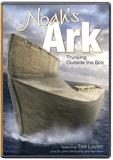National Geographic’s Article Misses the Boat
Is the account of the Ark of Noah plausible?
On March 27, 2024, National Geographic asked the question “Which animals were on Noah’s ark?” Now it is clear that they really were not serious about the question, as they believe the biblical account of Noah and the ark was just a fairy tale or a symbolic morality tale, akin to Aesop’s fables.
To give author Erin Blakemore credit though, she does start with the premise that she would examine the animals on the ark as they have been depicted throughout history, focusing mostly on the Medieval and early Renaissance periods. At the end of the article, she argues that these discussions about which animals were on the ark and hybridization actually spurred the conversation about the biological concept of species.
Medieval Ark Depictions
Blakemore starts out with some eleventh-century English texts—one of which has an illustrated depiction of the animals as they disembark. These include sheep, cows, pigs, deer, and several birds. By the fifteenth century, carvers at the Norwich Cathedral in England depicted Noah with not just cattle and birds but a monkey—an animal that, though not native to England, would have been familiar due to the menageries and court entertainments of the time. Trade with African and Mediterranean merchants made people in England aware of giraffes, peacocks, and lions which were also depicted in ark imagery of the era.1 She also mentions the fanciful inclusion of “unicorns,” which at the time were the classic fairy-tale version, a horse with a large single (usually spiraled) horn on its head. This was likely due to England’s unfamiliarity with the rhinoceros or perhaps Elasmotherium.
Then Blakemore pivots to discuss the number of animals on the ark and how they were depicted as being housed. First, she muses on what she considers “fanciful” animals like unicorns and dragons and wonders how anyone could have thought they were real, basically stating that they only viewed such animals as symbolic until after the Reformation.2 We’ll get into this a bit later, but this dismissal of such animals seems incongruent with statements she makes earlier.
Renaissance Ark Depictions
The shift in focus for the sixteenth- and seventeenth-century ark depictions is not just an increased focus on the number of animals but also on what the ark looked like, how the interior looked, and how the people and animals were housed. Long before John Woodmorappe’s seminal book, Noah’s Ark: A Feasibility Study (first published in 1996), and Dr. Tim Chaffey and Laura Welch’s book Inside Noah’s Ark (2016), there were much earlier precursors trying to figure out the same things.
The first author mentioned in this section of the article was Johannes Buteo’s pamphlet “De Arca Noë,” which was published in 1554. Buteo developed a detailed design of Noah’s Ark, which included space for all the animals and provisions. Next came German polymath and Jesuit Athanasius Kircher, who did a more exhaustive treatment with his (similarly named) Arca Noë. Kircher’s 1675 book looked at all aspects of selecting, caring for, and fitting all those animals on the ark.3 For a detailed look at his cross-section of the ark, see here: https://honorsbookculture.ace.fordham.edu/neatline/fullscreen/mapping-of-kirchers-arca-noe.
Both Buteo’s and Kircher’s books, as well as other mathematicians like Benito Periera and the explorer Sir Walter Raleigh, wrote about the dimensions of the ark and even tried to pinpoint where the ark landed. Buteo and Kircher both utilized the rectangular ark as their base design, not some silly-looking bathtub ark.
The Ark Kinds and the Search for the Animals on Board the Ark
As depictions of the ark became more concerned with space and animal enclosures, it is no surprise that great thought went into which animals were on board.
As depictions of the ark became more concerned with space and animal enclosures, it is no surprise that great thought went into which animals were on board. The initial conversations revolved around hybrids. Being centuries before genetics was formalized (and even before Linnean classification), most guesses were based on which animals they were familiar with being able to hybridize. So arguments that mules or domestic pigeons (for example) wouldn’t be on the ark started scholars down the road of which animals at that time were hybrids of the original biblical kinds. Some hybrid speculation turned out to be way off target, but the more reasoned and conservative estimates produced some interesting ark kind numbers.
Kircher reasoned that Noah would only have needed 130 types of four-footed mammal, 30 snake species, and 150 bird species to repopulate earth after the flood (keep in mind that at this time “species” meant the biblical kind, whereas “hybrid” would equal species or subspecies). Also notice that Kircher did not include lizards, amphibians, and bats and likely did not include unknown (to him) extinct kinds. Nor did he multiply by two for the unclean or seven (or 14) for the clean kinds. Just taking those numbers and doing the simplest multiplication 130 x 2 + 30 x 2 + 150 x 7, Kircher would have had 1,370 animals on the ark (or 2,420 if he had 14 clean birds of each kind). Had some of the mammals been clean ones (as they most certainly would have when including sheep, cattle, etc.), the number would have been much higher, likely over 3,000 animals.
Compare that to the statement on the Ark Encounter’s website: “Recent studies estimate the total number of living and extinct kinds of land animals and flying creatures to be 1,398. With our ‘worst-case’ scenario approach to calculating the number of animals on the ark, this would mean that Noah cared for 6,744 animals.” So Kircher did a good job with the knowledge he possessed of animal kinds at the time.
How Did Ark Kinds Give Birth to the Concept of Species
Blakemore argues that “the ideas birthed by Kircher, Buteo, and others actually ended up helping birth the concept of biological species beginning in the sixteenth century. The idea was unheard of before these mental experiments with Noah’s menagerie, which pushed scientists like Buteo and Kircher to classify and rank animals in an attempt to determine whether they’d have been ark-worthy.”4
But Blakemore then dismisses the importance of this by stating the idea that all animals that could have been passengers on the ark was quickly becoming untenable as new species were discovered. Again though, she misunderstands that Noah did not have to take species on the ark, but rather biblical kinds, approximately equal to the family level of classification. However, as author John Wilkins notes: “There was no concept of biological species before the late 17th century in natural history. So why did we get a concept of species in the first place? What is ‘species’ needed for? The answer is that the reason we have a notion of species in biology at all is because of Noah’s Ark. . . . The trend towards literalism in biblical interpretation after the Reformation, and the rapidly increasing number of species described by European naturalists as the Americas and the Orient were explored, raised an urgent question. Could the story of Noah’s Ark be true?”5
Those Mythical Animals
Blakemore’s dismissal of certain animals because she deems them “mythical” is surprising because she makes the point earlier in the article that:
European artists with little knowledge of the breadth of global wildlife, included animals that would have been familiar from everyday life. For example, the Old English Hexateuch, an 11th-century Anglo-Saxon manuscript, shows cows, goats, and pigs—common European domesticated animals—leaving the ark in twos.
More exotic animals depicted in other manuscripts, though, indicate medieval Europe’s increased contact with the rest of the world, first through trade and then through international exploration.6
Depictions of animals are thus described by Blakemore as ones the people of that time and location were familiar with (unless she deems them fantastical). But the biblical account has no such “mythical” descriptions. In fact, the only two animals actually named are the raven and the dove. The account is straightforward and merely states that Noah was commanded to bring two of every kind of land-dwelling, air-breathing creature along with seven (or seven pairs) of clean and flying animals.
Taken at face value, the flying and land-dwelling creatures had been created on days five and six, respectively, at the time only 1,656 years before the flood (according to Ussher, who counted up the pre-flood patriarchs’ lifespans and overlaps). Therefore, the ark’s occupants would have included pterosaurs, dinosaurs, and “unicorns” (rhinos and/or Elasmotherium). And there are plenty of accounts (as well as drawings, carvings, and petroglyphs) of post-flood peoples interacting with these creatures.
Because evolutionary scientists and liberal scholars have relegated the Noah’s ark account as mythic or symbolic, the account is ignored by them.
Because evolutionary scientists and liberal scholars have relegated the Noah’s ark account as mythic or symbolic, the account is ignored by them or, at best, is taught in liberal theological circles as a morality tale. But Jesus warned that his return would be at a time like when the flood came (Matthew 24:37–39). And the writer of Hebrews as well as Peter confirmed the historicity of the flood (Hebrews 11:7; 1 Peter 3:20; 2 Peter 2:5). Peter also ties in the judgment of the flood with the judgment at the time of Christ’s return (2 Peter 3:3–7).
The flood account is not a myth but a divine warning. Just as Noah and his family and all the animals had to enter the one door on the ark in order to be spared divine judgment, so must everyone today enter the one door of Jesus to be saved (John 10:7–9).
This article, though well written and at times quite engaging, tries to set up straw men and tear them down. Yes, there were some fanciful depictions of the ark and its occupants, just as there are “bathtub” arks today. But mankind’s failure to accurately portray the animals on the ark in no way detracts from the historicity of the account. Unfortunately, National Geographic misses the boat in terms of honestly dealing with Scripture here.
Footnotes
- Erin Blakemore, “Which Animals Were on Noah’s Ark? These Are History’s Theories,” National Geographic, March 27, 2024, https://www.nationalgeographic.com/premium/article/noahs-ark-animals.
- Blakemore, “Which Animals Were on Noah’s Ark?”
- Blakemore, “Which Animals Were on Noah’s Ark?”
- Blakemore, “Which Animals Were on Noah’s Ark?”
- John Wilkins, “We Have ‘Species’ Thanks to Noah’s Ark,” The Conversation, October 28, 2013, https://theconversation.com/we-have-species-thanks-to-noahs-ark-19542.
- Blakemore, “Which Animals Were on Noah’s Ark?”
Recommended Resources

Answers in Genesis is an apologetics ministry, dedicated to helping Christians defend their faith and proclaim the good news of Jesus Christ.
- Customer Service 800.778.3390
- © 2024 Answers in Genesis





